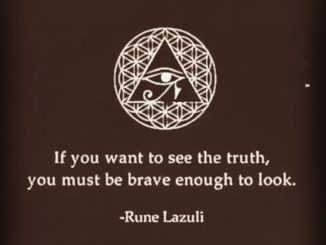
The "Observer Effect" (sometimes called the Measurement Problem) suggests that the very act of you observing (or measuring) something requires a change in the behavior or properties in what you are observing, which doesn't tend to be what you observe based on your everyday ordinary experiences. A red traffic light won't immediately change to green just because you stare at it and wish it so. Measuring out how much sugar you have in your sugar-jar doesn't change the amount of sugar present.
Of course you yourself have proprieties which in theory could have an effect on what you are observing. You have mass and thus gravity; you're slightly radioactive; lots of other things, mainly photons, are emanating from you (ie – infra-red or heat photons) or bouncing off of you (ie – visible light photons, etc.). But the net effect on what you are observing is so minimal as to be nearly non-existent. And in any event, it's pretty much non-calculable since everything else in that object's environment, and that pretty much means the entire visible Universe, also has mass, is slightly radioactive and emits and / or gives off photons. Both electromagnetic radiation and gravity have potentially infinite range and no object can escape their influence. Your influence is tiny compared to that of the rest of the visible Universe!
The question really boils down to, what's different about you when you are observing something (eyes open) versus when you are not observing that something (your eyes are shut or your back is turned)? The same applies to a detector like a camera, which for our purposes is considered an 'observer' too. Should a camera with an open shutter have any different an effect on what's being photographed relative to when the shutter is closed? No, shutter / eyes open versus shutter / eyes closed should have no difference in having an effect on what is or is not under observation. You or the camera have the exact same mass (gravity), radioactivity or photon emission / reflection regardless of eyes / shutter open versus eyes / shutter closed.
Alas for this exquisite line of reasoning, there is one scenario where it has been proven that the very act of observation does change the behavior of what's under observation. That's the famous, or infamous Double-Slit Experiment. To make a long story very short, particles fired at two slits exhibit wave behavior (known in the trade as "wave-particle duality") when they pass through both slits if unobserved. The nanosecond that an observer makes like a Peeping-Tom the wave behavior morphs into discrete particle (ie – bullet) behavior. No peeping – waves; peeping – particles.
Apart from that Double-Slit Experiment, there is NO observer (or detector) effect! Exceptions to the rule require explanations which I'll get to shortly. Meantime …
1) If there were such a thing as an "Observer Effect", that alone would imply the reality of telekinesis. Telekinesis has never been demonstrated to the satisfaction of the overall scientific community.
2) If there were such a thing as an "Observer Effect" then no scientist could take any experimental result at face value on the grounds that that the scientist himself affected the outcome of the experiment just by being in the vicinity.
3) The wholeety of the scientific method and all scientific results would be called into question if there were really an "Observer Effect". All scientific texts would have to start with the disclaimer that "what you are about to read may have no correspondence to actual reality".
4) Schrodinger's Cat IS NOT alive AND dead; Schrodinger's Cat IS alive OR dead and that is true independent of any observer. By implication, there is no such thing as an actual superposition-of-state and no such thing as an observer collapsing the alleged wave-function. Which brings up an obvious question. In the absence of determ / detectors, what is collapsing all those wave-functions arising from those billions upon billions of superposition-of-states that arises daily in the Universe?
5) There's no "Observer Effect" with respect to the Heisenberg Uncertainty Principle since what transpires is independent of any observer. The observer may not know, cannot know in fact, with precision both the position and momentum of a particle, but that does not mean that the particle does not have a precise position and a precise momentum at any given instant in time. This also implies that I don't accept the idea that the object in question in the Heisenberg Uncertainty Principle is both a wave and a particle at the same time.
6) No other quantum mechanical or classical physics process seems to be affected by the presence or absence of any observer. That applies to quantum tuning; radioactive or neutron decay; the creation and annihilation of 'virtual particles'; conservation of mass / energy, momentum, electric charge, etc .; chemical reactions; the speed of light and other physical constants.
My basic premise here is that we 'exist' as virtual reality beings in a simulated landscape. Our Universe is a computer / software-generated Universe by an agent or agencies unknown. However, this agent, The Simulators, have programmed in sufficient clues to enable us to figure it all out. That's assuming we are intelligent enough to note when things fall into the category of "that's really strange" then figure out an explanation (s). I suggest that one major set of clues are what we would call "exceptions to the rule".
The "Observer Effect" in the Double-Slit Experiment is one such exception to the rule. Another is that the speed of light is the exception to the rule that you can otherwise add and subtract velocities. Dark Energy is the exception to the conservation of energy law.
Then there is the weak nuclear force and parity. In the standard model of particle physics, with respect to the four forces – electromagnetism, gravity, the strong nuclear force and the weak nuclear force – if you reverse the three parameters of time, charge and parity (left-right) all of the various laws, principles and relationships should still strut their stuff unaltered. And in 11 out of 12 cases, that's what experiments and the equations show. But, in that 12th case, experimental evidence suggests that parity is not equal in the weak nuclear force. I forget now which it is, but either there is a left bias or a bias towards the right (I seem to recall it was a left-hand bias) – but in theory there shouldn't be any bias at all.
There are another whole set of clues called "anomalies". These often center around the "I know what I saw" position of the believer versus the "It can't be therefore it isn't" position of the skeptic. However, some anomalies are so in-your-face that something other than "It can't be therefore it isn't" is required to explain things. One such anomaly has to be the Crop 'Circle' enigma. Another has to be the missing 'natural' satellite of Venus, Neith. A third has to be the extraordinary number of rocks on Mars photographed by the various Martian rovers that have a rather uncanny resemblance to actual living or intelligently designed objects here on Earth. One or two or even three might be expected, but when it hits way more than a dozen, well something is screwy somewhere.
There are another whole set of clues called "paradoxes":
1) Quantum entanglement is a paradox in that it seemingly violates cosmic speed limit; the speed of light.
2) Mind / body dualism is paradoxical;
3) The Universe must be as one with itself, yet it is two parts – one part quantum and one part gravity. The two parts cannot be unified which is paradoxical.
In conclusion, any demonstration of "The Observer Effect" or "The Measurement Problem" is readily explainable by what Hollywood would term "special effects", which is something that computer software programming excels at.
Proudly WWW.PONIREVO.COM
Source by John Prytz



